| Author |
Message |
|
Johnson T.
|
 Posted: Tue 28 Aug, 2012 12:44 am Post subject: Size and frequency of bosses on kite shields Posted: Tue 28 Aug, 2012 12:44 am Post subject: Size and frequency of bosses on kite shields |
 |
|
Ello folks.
I notice on many reenactor's gear, their kite shields, full sized bosses aren't often used. As we all well know, bosses on kite shields are, as far as we can guess, purely decorative. An ornament left over from a past time.
But are these oddly small bosses due to the reenactor not wanting to carry so much weight, or were small bosses always used on kite shields?
Here are two bosses. The first one is a full sized boss. On the other page, scroll down to kite shields and check out the size. This is only one small example, I find a large amount of reproductions use small bosses, smaller than 4".
http://www.medieval-fightclub.com/products/Do...umbo).html
http://www.shieldsplus.co.uk/page2.htm
Now as we move furthur in history, we lose the teardrop shape and the bosses. When did this exactly happen? Did this happen sometime after 1066 (such as after William's final death, around 1100 AD). Or did it happen before this? Were bosses EVER used on these developed kite shields?
Cheers guys, I appreciate any help given.
|
|
  |
 |
|
Mart Shearer
|
 Posted: Tue 28 Aug, 2012 12:34 pm Post subject: Posted: Tue 28 Aug, 2012 12:34 pm Post subject: |
 |
|
Certainly bosses weren't always used, but I would be hesitant to presume they're all ornamental. Here's some "kites" with bosses in use in the Bible of Stephen Harding, 1109-1111.
http://www.culture.gouv.fr/Wave/savimage/enlu...3739-p.jpg
Bosses sometimes continue in use after the kite loses its rounded top in the 12th century. The Copenhagen Psalter, English 1175-1200 with a small boss:
http://www.kb.dk/permalink/2006/manus/242/eng/15+recto/?var=1
An example of a boss dating from before 1290:
 Attachment: 97.86 KB Attachment: 97.86 KB

ferrum ferro acuitur et homo exacuit faciem amici sui
|
|
  |
 |
|
William P
|
 Posted: Wed 29 Aug, 2012 12:35 am Post subject: Posted: Wed 29 Aug, 2012 12:35 am Post subject: |
 |
|
well there is one OTHER function the boss has that in theory could also be achieved by a flat iron plate
a boss on a strap gripped shield thats level with your arm, means that a hit that is aimed at that area which might otherwise perforate the shield and thus your arm, will instead hit the boss and glance to the side, also..
its handy for shoving into someones face, lastly i hear that in roundshield techniques the body may have been integral to recieving strikes essentially, iff you hold the shield, arm outstretched, rim facing enemy the guy strikes downward, the small narrowed neck i see on alot of viking bosses might help intercept a blow and trap it for a moment maybe??
|
|
   |
 |
|
Scott Woodruff
|
 Posted: Wed 29 Aug, 2012 6:23 pm Post subject: Posted: Wed 29 Aug, 2012 6:23 pm Post subject: |
 |
|
|
Small bosses were indeed the norm on kite shields during the 11th century. During the next two centuries they became more and more rare and also showed greater variety in size. Its coninued use may have had a lot to do with tradition, but though its is not vital on a kite shield the way it is on a center-grip, it still has some function. As William said, it does give some added protection to a critical point, and it also has some offensive value and depending on the shape can catch or obstruct a sword blade, keeping it from sliding right off the shield and helping the warrior to tie up his opponent. Here is a link that has an example of a small kite shield boss, scroll down about half way down to the shield section: http://www.reenactment.de/reenactment_start/r...guide.html
|
|
  |
 |
|
Fabrice Cognot
Industry Professional
|
 Posted: Wed 29 Aug, 2012 6:45 pm Post subject: Posted: Wed 29 Aug, 2012 6:45 pm Post subject: |
 |
|
Hi all
"Decorative" is not the word I would use. Sure, it certainly served less practical a function than when it served to cover the central handle. But reducing it to a purely ornamental role is a bit too much, in my view.
Arms and armour is a domain in which innovation and invention coexist with a great deal of what I call "inertia" i.e. the need to keep things as they used to be (some aspects of them at least) - to make a long story short, it's the same phenomenon that explains the notch at the base of Kukri blades and so many other things. The evolution of arms and armour is not limited to the rational, for obvious reasons.
This phenomenon is especially strong in Medieval times, probably due to the way technical know-how was transmitted (in a "my Master taught me to do things this way, so this is the way I'll do things" fashion).
Keeping the boss on the shield would therefore (but I'm taking shortcuts there) simply mean that without it, the device would not have been a shield.
Oh, and it also looks nice  . .
Mark : the Harding bible is kept here, in my hometown. I kind of know it well. This manuscript does show shields with bosss, but the grip here is still somehow central (fol. 191 for instance shows the inside of a shield : you can clearly see what can be interpeetated as two leather straps serving as handles). However, a closer look reveals that the position of the hand does not totally correspond with the position of the boss. Another manuscript, ms. 173, although not showing shields from their outer side, depicts a character with what is clearly a non-central grip of a shield (with enarmes) that one can suppose being of the same type as the others (these manuscripts were made at the ame place at the same tipe - a span of 2 years).
Although both can also be artistic license...
The ms. Nouvelle Acquisition Latine 1390 kept at the B.N.F. shows something interesting, however : on folio 7 you can see a norman fleet, with mail-clad warriors equipped with long shields with central bosses ; but on the verso you can clearly see the way they were held (along with beautiful swords with brazil-nut pommels) : totally non-central.
So...shields with bosses, even when used with a non-central grip, were in use for some time - which doesn't mean this boss was non-functional. Its possible functions were not "practical", but they still had some significance, although we can't even hint at what they exactly were.
Cheers
Fab
PhD in medieval archeology.
HEMAC member
De Taille et d'Estoc director
Maker of high quality historical-inspired pieces.
|
|
   |
 |
|
Mart Shearer
|
 Posted: Wed 29 Aug, 2012 8:08 pm Post subject: Posted: Wed 29 Aug, 2012 8:08 pm Post subject: |
 |
|
| Fabrice Cognot wrote: | Mark : the Harding bible is kept here, in my hometown. I kind of know it well. This manuscript does show shields with bosss, but the grip here is still somehow central (fol. 191 for instance shows the inside of a shield : you can clearly see what can be interpeetated as two leather straps serving as handles). However, a closer look reveals that the position of the hand does not totally correspond with the position of the boss. Another manuscript, ms. 173, although not showing shields from their outer side, depicts a character with what is clearly a non-central grip of a shield (with enarmes) that one can suppose being of the same type as the others (these manuscripts were made at the ame place at the same tipe - a span of 2 years).
Although both can also be artistic license... |
Dijon MS. 173--
http://www.enluminures.culture.fr/Wave/savima...4245-p.jpg
http://www.enluminures.culture.fr/Wave/savima...4255-p.jpg
http://www.enluminures.culture.fr/Wave/savima...4259-p.jpg
It's not as nice as being there, but there's much to be said for digitizing manuscripts.
ferrum ferro acuitur et homo exacuit faciem amici sui
|
|
  |
 |
|
Johnson T.
|
 Posted: Tue 02 Oct, 2012 1:22 am Post subject: Posted: Tue 02 Oct, 2012 1:22 am Post subject: |
 |
|
|
Mart Shearer, could you please tell me where the picture you embed into your post comes from maybe? I would be interested to find more pictures of the same form.
|
|
  |
 |
|
Mart Shearer
|
 Posted: Tue 02 Oct, 2012 7:46 am Post subject: Posted: Tue 02 Oct, 2012 7:46 am Post subject: |
 |
|
| Johnson T. wrote: | | Mart Shearer, could you please tell me where the picture you embed into your post comes from maybe? I would be interested to find more pictures of the same form. |
Placing the cursor over the embedded picture should give you the attribution, as I try to title pictures with the source.
ValenciennesBM MS.320 fo46r-2
This indicates the Valenciennes, France Bibliotheque Municipale manuscript number 320, folio 46 recto, and the second image on that page.
http://www.enluminures.culture.fr/documentation/enlumine/fr/
Choose research guide
http://www.enluminures.culture.fr/documentati...dee_00.htm
Scroll down the left to Valenciennes (or other city of your choice)
http://www.enluminures.culture.fr/documentati...iennes.htm
Pick MS.320
I don't think you'll find any other shields in this manuscript besides a few bucklers (fo044r).
Alternately, you can go to the research expert selection, and narrow down manuscripts by date. I've been sending images from the Enluminures site to http://manuscriptminiatures.com/ on a daily basis, but it takes a while to get them uploaded to the site, and I'm currently sending the images from Lyon, so it will take a while to get them all, even though I've pulled all the pre-1450 armor images. Manuscript Miniatures also has a search function by date.
What specific part of the form are you interested in, shape, animal head bosses, something else?
ferrum ferro acuitur et homo exacuit faciem amici sui
Last edited by Mart Shearer on Tue 02 Oct, 2012 8:19 am; edited 1 time in total
|
|
  |
 |
|
Mart Shearer
|
 Posted: Tue 02 Oct, 2012 7:55 am Post subject: Posted: Tue 02 Oct, 2012 7:55 am Post subject: |
 |
|
A small spike-boss from c. 1100, from the Vita et miracila s. Mauri, Troyes Bib. Mun. MS.2273 fo.092v:
 Attachment: 187.34 KB Attachment: 187.34 KB
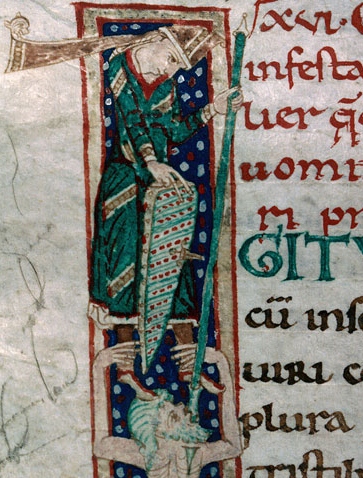
ferrum ferro acuitur et homo exacuit faciem amici sui
|
|
  |
 |
|
Johnson T.
|
 Posted: Tue 02 Oct, 2012 11:48 pm Post subject: Posted: Tue 02 Oct, 2012 11:48 pm Post subject: |
 |
|
Mart, you are a pro! I'm very eager to check out these images. The two pictures you embed I'm very interested in, their particular style just hooks me.
The animal head boss you posted is fantastic. It makes me wonder if it was the artist or if metal was formed to look like that, or maybe it was painted with a head on it. The range of bosses suggests that artistic license contributes greatly or that there are more of them that have not survived time.
The Valenciennes looks as if it's a bestiary or something. The 320 looks like a bestiary but what are the other pages? Part of the same manuscript or different ones? How do I know where it says what date each manuscript is? Let me know if I'm correct, Valenciennes is the place they came from and the numbers (320 for eg) divide up the different manuscripts from there.
I'm interested in all bosses you can find. Especially odd unique ones too. Kite shields I'm very interested in as well so keep an eye out. Also helmets of all types, especially great helmets.
|
|
  |
 |
|
Johnson T.
|
 Posted: Wed 03 Oct, 2012 12:42 am Post subject: Posted: Wed 03 Oct, 2012 12:42 am Post subject: |
 |
|
The great thing about manuscripts is we can see exactly what they wore. Assuming they're accurate. Even if the pictures are drawn of the imagination they do tell us what it could of been.
So when I see pictures of kite shields with paint jobs or cool bosses it adds to the big puzzle of 'what could of been on a kite shield', even if X wasn't ever on a kite shield. We do not live in the Medieval times anymore friends, but we can still pretend.
The Maceijowski Bible: http://www.medievaltymes.com/courtyard/maciejowski_images_10.htm
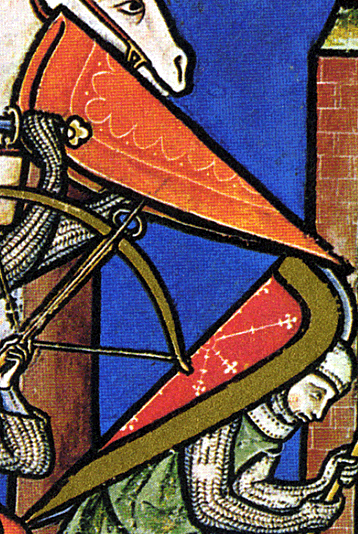
|
|
  |
 |
|
Mart Shearer
|
 Posted: Wed 03 Oct, 2012 8:09 am Post subject: Posted: Wed 03 Oct, 2012 8:09 am Post subject: |
 |
|
| Johnson T. wrote: | The Valenciennes looks as if it's a bestiary or something. The 320 looks like a bestiary but what are the other pages? Part of the same manuscript or different ones? How do I know where it says what date each manuscript is? Let me know if I'm correct, Valenciennes is the place they came from and the numbers (320 for eg) divide up the different manuscripts from there.
I'm interested in all bosses you can find. Especially odd unique ones too. Kite shields I'm very interested in as well so keep an eye out. Also helmets of all types, especially great helmets. |
Yes, Valenciennes is the city which holds the manuscript (not necessarily where the manuscript was originally made), and the 320 is like the shelfmark used in the library to identify different books marked on the spine. On the Enluminures site, the date, title, and other information is found by clicking the small blue page icon beneath the thumbnail picture. In the case of Valenciennes MS.320, it is a copy of de Natura rerum , (of the nature of things) with an added bestiary in the same manuscript from c.1290.
There are literally hundreds, if not thousands, of manuscript images of great helms or shield bosses. You really need to narrow your inquiry to something like, "embossed, decorative shield bosses" or "helms from 1230-1250" to get much input from others. Learning how to ask a good question is half the battle. Of course you are interested in everything, but limiting inquiries to something like, "shields in the first half of the 11th century" helps others help you
Regarding other traditional "kite" shields, with the rounded tops, here's a few more images, some with bosses-some without, and others showing the grips and guiges:
Bible, Reims Bib. Mun. MS.23, 1101-1125, France
Tractatus in Evangelium Johannis, Tours Bib. Mun. MS.291, c. 1105, Tours, France
 Attachment: 223.77 KB Attachment: 223.77 KB
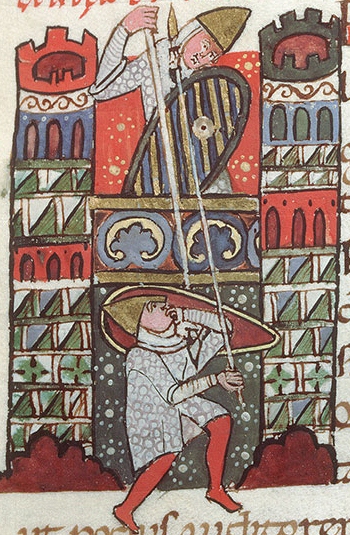
 Attachment: 139.37 KB Attachment: 139.37 KB

 Attachment: 204.73 KB Attachment: 204.73 KB
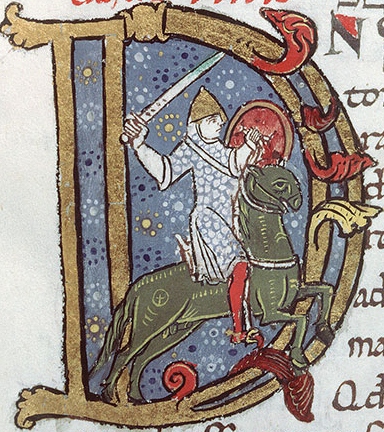
 Attachment: 172.16 KB Attachment: 172.16 KB
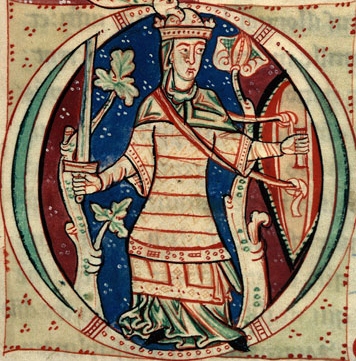
 Attachment: 192.46 KB Attachment: 192.46 KB
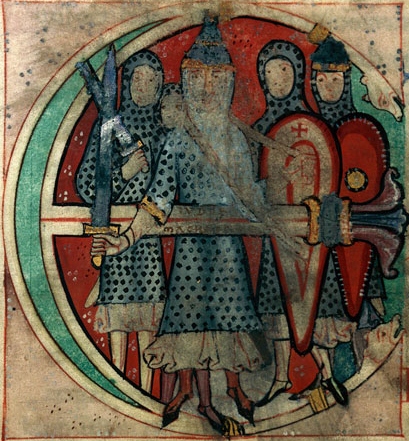
ferrum ferro acuitur et homo exacuit faciem amici sui
|
|
  |
 |
|
Johnson T.
|
 Posted: Thu 04 Oct, 2012 1:29 am Post subject: Posted: Thu 04 Oct, 2012 1:29 am Post subject: |
 |
|
Cheers for being such good help Mart. Let me narrow down my inquiry, I didn't ever realize that so much survived. 
Well do you know if the manuscripts they have on here are complete? Have they taken pictures of everything they have or just parts of it? If this is all there is then, per manuscript, not much survives. There are hundreds of manuscripts but only several pages from all each.
Is every single known manuscript on this website or maybe just ones held in France now?
I've found that the designs people put on kite shields are very unmotivated. It's not like I'm saying they aren't good, but they use the same old designs from the Bayeux Tapestry (atleast for 11th kites). What I'd really like to see are kite shields which have unique paintings on them. Not just plain ones, I want to see examples of pretty early heraldry on kites.
Furthurmore, any unique bosses are a great help. Bosses featuring strange decorations or animals or shapes.
Last edited by Johnson T. on Thu 04 Oct, 2012 2:22 am; edited 1 time in total
|
|
  |
 |
|
Johnson T.
|
 Posted: Thu 04 Oct, 2012 2:11 am Post subject: Posted: Thu 04 Oct, 2012 2:11 am Post subject: |
 |
|
Tours MS #25 Late 12th Cent.
 Attachment: 169.39 KB Attachment: 169.39 KB
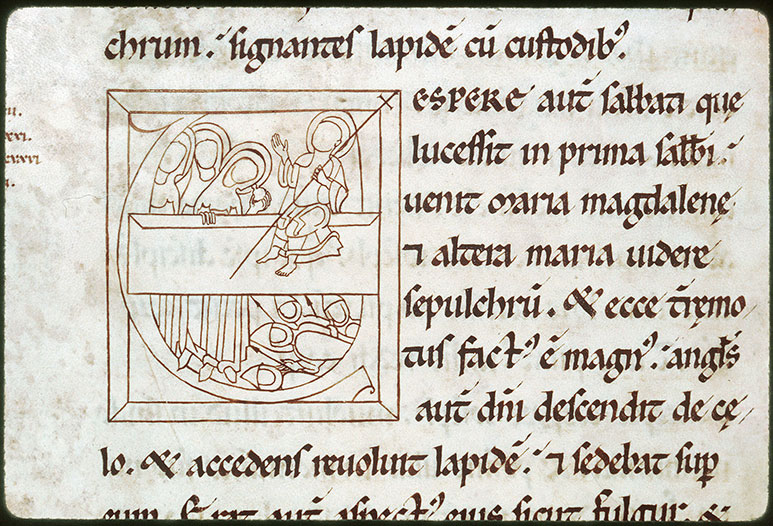
|
|
  |
 |
|
Mart Shearer
|
 Posted: Thu 04 Oct, 2012 7:50 am Post subject: Posted: Thu 04 Oct, 2012 7:50 am Post subject: |
 |
|
| Johnson T. wrote: | Cheers for being such good help Mart. Let me narrow down my inquiry, I didn't ever realize that so much survived. 
Well do you know if the manuscripts they have on here are complete? Have they taken pictures of everything they have or just parts of it? If this is all there is then, per manuscript, not much survives. There are hundreds of manuscripts but only several pages from all each.
Is every single known manuscript on this website or maybe just ones held in France now?
I've found that the designs people put on kite shields are very unmotivated. It's not like I'm saying they aren't good, but they use the same old designs from the Bayeux Tapestry (atleast for 11th kites). What I'd really like to see are kite shields which have unique paintings on them. Not just plain ones, I want to see examples of pretty early heraldry on kites.
Furthurmore, any unique bosses are a great help. Bosses featuring strange decorations or animals or shapes. |
The Enlunimures site is only manuscripts held in the municipal libraries in France, and only offers excerpts. The French National Library (BNF) has it's own site.
http://mandragore.bnf.fr/html/accueil.html
No one has completely digitized their collections. Some manuscripts, say an Arthurian Romance or History of the Trojan War might have 150 armor related miniatures each, while others may have hundreds of miniatures but none showing armor. Many manuscripts are text only, and others contain a small number of images--like books today. Many European nations have their national libraries collections online (Britain, Netherland, Denmark, Spain, Austria) while others have many collections in universities (Germany, Britian) or art museums as well.
I don't think you'll find any heraldry before the time of Geoffrey Plantagent, Count of Anjou from c. 1151. There are decorative items painted before that date, but they may be unit identification rather than personal and hereditary heraldry.
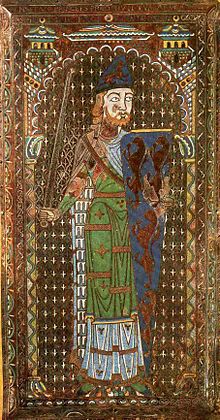
ferrum ferro acuitur et homo exacuit faciem amici sui
|
|
  |
 |
|
Len Parker
|
|
  |
 |
|
Mart Shearer
|
 Posted: Thu 04 Oct, 2012 2:53 pm Post subject: Posted: Thu 04 Oct, 2012 2:53 pm Post subject: |
 |
|
Thanks Len,
As that brings up a good research point. Don't rely on a single source, like the Bayeaux Tapestry, or even a single class of sources such as manuscripts. Here's the Temple Pyx figures from 1140-1150 as another example, something you might have missed if you only looked at manuscripts.
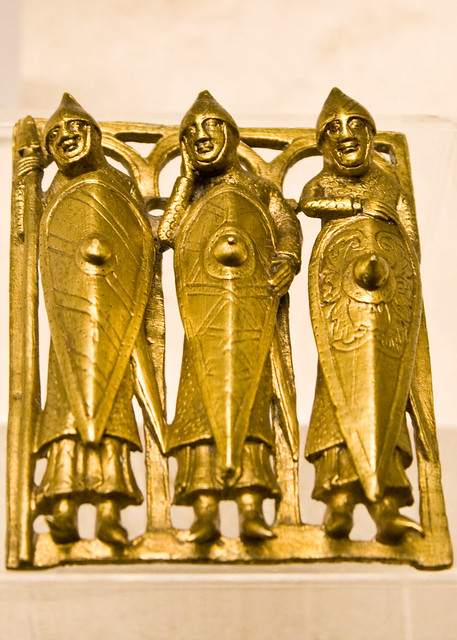
ferrum ferro acuitur et homo exacuit faciem amici sui
|
|
  |
 |
|
Johnson T.
|
 Posted: Fri 05 Oct, 2012 4:16 am Post subject: Posted: Fri 05 Oct, 2012 4:16 am Post subject: |
 |
|
The amount of information out there is great. Statues, manuscripts, effigies, carving, stained glass, artifact. Man, well thank you Lenny for that! I'm going to research statues.
I love that figure Mart but I didn't know it had a name. FInally I know what it is. There is plenty of detailed beautiful heraldry before 1151. All those manuscripts you posted feature magnificent paint jobs.
Mind you this was before heraldry so we assume the artist either did them or knights just went painted shields as they want.
|
|
  |
 |
|
|
You cannot post new topics in this forum
You cannot reply to topics in this forum
You cannot edit your posts in this forum
You cannot delete your posts in this forum
You cannot vote in polls in this forum
You cannot attach files in this forum
You can download files in this forum
|
All contents © Copyright 2003-2024 myArmoury.com — All rights reserved
Discussion forums powered by phpBB © The phpBB Group
Switch to the Basic Low-bandwidth Version of the forum
|

